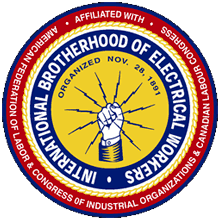April 29, 2013
By Steven Wishnia
“No more workers have to die,” the more than 100 people chanted, their voices reverberating off the corrugated-metal scaffolding overhead as they read the names of workers killed on the job in the last two years. “Francisco Ortiz.” “¡Presente!” “Han Wa Lee.” “¡Presente!” “Valentine Campbell.” “¡Presente!”
The occasion was April 28, Workers Memorial Day, and the rally’s organizers, the New York Committee on  Occupational Safety and Health and the New York City Central Labor Council, picked the building, Stella Tower at 425 West 50th St., because two construction workers have been injured there in the last three months. The developers have been using nonunion labor to convert it from a phone-company facility to luxury condos they’re trying to sell for $1.5 million to more than $9 million.
Occupational Safety and Health and the New York City Central Labor Council, picked the building, Stella Tower at 425 West 50th St., because two construction workers have been injured there in the last three months. The developers have been using nonunion labor to convert it from a phone-company facility to luxury condos they’re trying to sell for $1.5 million to more than $9 million.
A short, burly, shaven-headed supervisor stormed out of the building, calling for police to move the protesters on. “Right in front of my door,” he raged. Most of the workers visible from the street weren’t wearing hard hats.
“We come in a spirit of mourning, a spirit of sorrow, but also a spirit of resistance, a spirit of rage,” Rabbi Michael Feinberg said as the rally began, on the 51st Street side of the building.
Construction is the most dangerous job in New York, according to “It’s No Accident,” a NYCOSH report released at the rally. Of the 196 people killed on the job in the state in 2012, almost one in five worked in the building trades, even though they account for only 4% of total employment. One-third of the people who died were immigrants—including half of those killed in construction accidents—and more than one-third were over 55.
“Many deaths could have been prevented,” NYCOSH executive director Charlene Obernauer told the crowd. Two-thirds of building sites inspected by the federal Occupational Safety and Health Administration between 2010 and 2012 had at least one “serious” violation, she said, and OSHA has only 71 inspectors covering the New York City metropolitan area.
In addition, the report said, “OSHA has no authority to monitor the safety of self-employed workers,” who are about a quarter of those killed on the job, up from less than 10% in 2000. This increase, Obernauer said, is not because they’re entrepreneurs, but because employers are misclassifying them as “independent contractors.”
Preserving the state’s scaffolding law, she added, is “critical, critical, critical.”
The report also recommends enacting federal legislation to increase fines and criminal penalties if a worker is killed on a site with chronic violations, and that OSHA increase inspections in industries where a lot of immigrants work and hire more inspectors who know common immigrant languages.
Immigrant workers are often pressured to work at an unsafe pace, said Pedro Auquilla, who came here from Ecuador in 2000, works in carpentry and demolition, and is now involved with the Workers Justice Project in Queens.
A group from the International Alliance of Theatrical Stage Employees carried “Safety for Sarah” signs, in memory of Sarah Jones, a 27-year-old camera assistant killed in February when she was hit by a train while shooting a movie on a railroad bridge in rural Georgia.
In researching on-the-job deaths, NYC CLC chief of staff Brendan Griffith said, “the most astonishing thing is how difficult it is to learn the name of the worker.”



